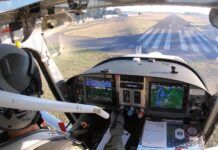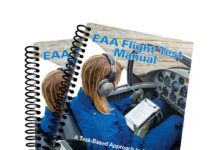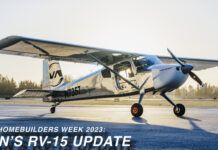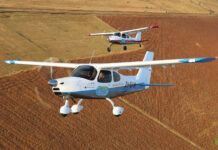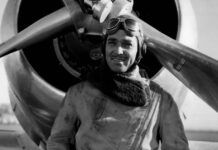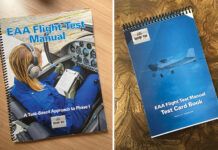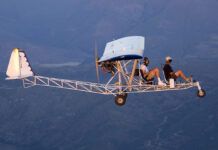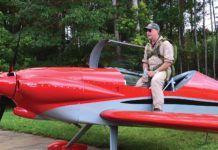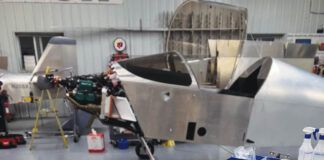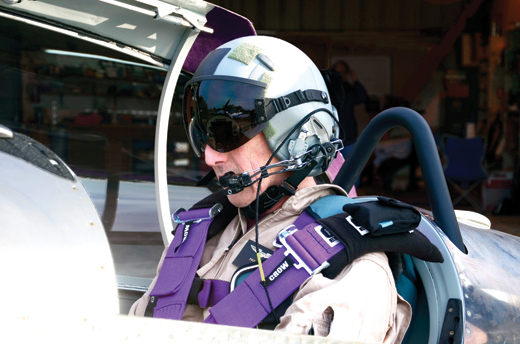 In the first installment of this series, we talked about the need for thorough planning before any test flight, especially the first one of a new airplane. Planning the flight is key to successful risk identification and management and should start well before the airplane’s engine does. Whether the builder decides to make that first flight or have someone else do it, the plan will identify to everyone involved the roles and responsibilities, goals and contingency planning necessary to keep everyone safe.
In the first installment of this series, we talked about the need for thorough planning before any test flight, especially the first one of a new airplane. Planning the flight is key to successful risk identification and management and should start well before the airplane’s engine does. Whether the builder decides to make that first flight or have someone else do it, the plan will identify to everyone involved the roles and responsibilities, goals and contingency planning necessary to keep everyone safe.
Once the plan is in place, you’re ready to fly, right? Well, not really. In this segment, we will talk about specific training for the all-important first flight. Even if you are (or your designated test pilot is) current for normal flight operations, there are specific skills that need to be warmed up before setting out with a brand new Experimental aircraft. Just as an athlete would never think about starting a big game cold, we need to make sure that whoever is going to sit in the cockpit is 100% ready to go.
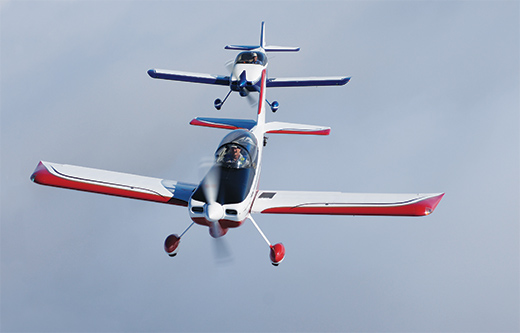
If a chase plane is in your plan, make sure that you and its pilot are experienced and current at formation flying. Practice inspection techniques and positions; this is not routine formation work.
The Value of Training
Think about this. You had to train to get your private license to learn the basics of taking (and keeping) an airplane aloft and not lost. If you have an instrument rating, you had to learn a new specialty: flying in the clouds and within the complexities of the National Airspace System. If you have a glider, balloon or seaplane rating, you needed special training in order to earn them, didn’t you? So why would test flying a new airplane be any different? Training in advance for a first flight is as important as learning to fly in a nicely coordinated manner (the reason that the commercial license exam expects you to fly chandelles, lazy eights and the like).
Interestingly, flying a good first flight shouldn’t require any more complex maneuvering than you need for a private license, which is probably why lots of homebuilders assume that they are fully ready to go take their new machine aloft —assuming they kept their Biennial Flight Reviews up to date. And legally, they’d be right. However (and it’s a big however), this is true assuming that only “normal” maneuvers are required. What happens if—heaven forbid—something goes wrong? When was the last time you practiced forced landings? Or figured out how tightly you could turn to set up for a landing in an airplane similar to the one you’ll be test flying? Have you flown an airplane significantly out of trim, or one with a faulty airspeed indicator? How about with a tachometer that is only reading half what it should? And what about having a full-blast squelch break in your ears because the radio wasn’t wired or set up right?
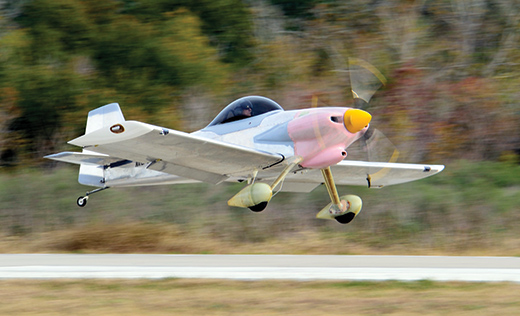
Spend time practicing landings from high- and low-energy conditions, making sure that you can hit your mark precisely and consistently. Fly an aircraft with similar performance to what you expect in the test aircraft.
These possible occurrences (and many others) are the reasons that as you get ready to fly, you should begin a training regimen tailored towards flight testing. Many builders aren’t current as they near completion on their aircraft, so the first thing they need to do is go and get some flight time. Really get current; don’t just shoot a few takeoffs and landings. Many builders quit flying altogether in the years leading up to the issuance of their airplane’s airworthiness certificate—these folks should find a good instructor who is willing to fly with them until they can at least pass a private checkride with flying colors. Then comes the next step: transition training into the type of airplane that you are going to fly.
The FAA has recently published an advisory circular (AC 90-109) that talks about the need for, and content of, good transition training. The circular goes so far as to list specific makes and models of airplanes that can be used to substitute for the Experimental that you are thinking of flying. While it won’t be identical in control layout or equipment, the substitute aircraft should give the pilot a good feel for speeds, rates of climb and sink, and overall maneuverability. Transition training should be done with someone who has experience in the type of Experimental that you are about to fly and can truly evaluate your readiness for the job. Listen to them—they have no interest in sending you off to damage an airplane and/or yourself. If nothing else, they don’t want a splotch on their record, even if they care nothing personally about you. Take their advice and training to heart, and don’t even consider taking that first flight if they don’t think you are ready.
OK, so you are legally current, and a good transition instructor has given you type-specific (or at least similar) training. Ready to go? Well, unless your transition training was at the same airport and the same day as you are going up for that first time in the new plane, you probably need to really sharpen yourself up with specific flight-test readiness in the week or so before going aloft. The flights need not be long, but you should fly regularly. Treat this like the warm-up before a sporting event. Here is one possible list of things you can do to be on top of your game.
Emergency Landing Practice
One of the most statistically significant emergencies in early flight testing is engine failure, followed by a forced landing. Now we all have done this drill many times in order to get our licenses, right? And after you were licensed, you probably kept your eyes open for good fields. You might have even done some local practice once in a while—pulling your power back (after picking a field in most cases…admit it!) and flying a pattern to 200 feet AGL, then adding power and congratulating yourself that “I could have made it in there.” Yup, we all played those games. Then we started flying passengers more regularly, and we didn’t want to scare them. And then, of course, we are off to meet the gang for a hundred-dollar hamburger; practicing emergencies along the way would make us miss that predetermined ETA. And going on a long cross-country—well, who’s going to practice emergencies when we’re on a flight plan, the wife is in the right seat and we’re loaded with fuel and baggage?
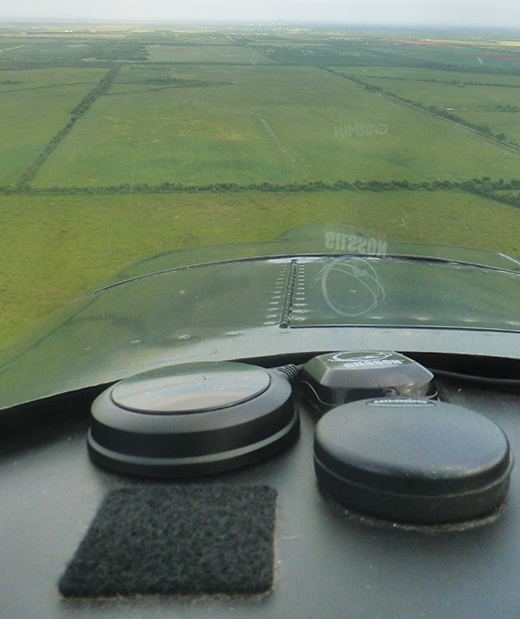
When was the last time you flew engine-outs? Practice power-off emergency approaches to the fields and roads in your test area. Don’t be satisfied until you can hit your desired spot every time. Use the time to scout the fields for furrows or other obstacles.
So maybe that skill is a bit atrophied? I make it a point in the week before a first flight to practice emergencies on every local flight—and I make sure that I go out and do local flights. Go find your favorite practice area with no wires, good fields and no neighbors to annoy, and pull the power in various locations relative to fields—upwind, downwind, 1000 feet AGL, 1500 feet…make each one different. Fly it low enough that you can be really honest: Would you have made it in there? Did you have to add a blip of power to “clear the engine” (and those wires)? Or were you going to be using the fence at the far end as an arresting cable to keep from going into the trees? If you did well and know it, pull the power as you climb through 500 feet and see what’s out ahead —dump the nose to get speed, and quick —pick a field! Think this is far-fetched? Fuel sloshing can cause an engine to not run, then run again…and then not.
The “Turn Back” Decision
While I almost hate to raise the subject of “turn-backs,” how about heading back up to altitude and seeing how much altitude you lose from an initial climb condition (nose high, full power, Vy) when you pull the power, count to three (to simulate shock and surprise), then dump the nose and initiate a 270˚ turn, followed by a 90˚ turn back to align with your “runway.” Do it a few times and see how much you lose. Oh, did you feel that buffet when you pulled too hard? Think how hard you might pull if the ground were coming up at you and the adrenaline was flowing. It’s a good exercise, not to train you to turn back, but to teach yourself not to turn back!
OK, once you have got those engine-outs done, pick out a practice “runway” (it could be a real one or a field simulating one) and pretend that you are orbiting the field in your new airplane, staying close enough to “make the runway” if the engine quits. Now pick some arbitrary point in your orbit and pull power. Did you make the runway? How was the maneuvering? Did you learn from where (in the pattern) it will work, and from where it won’t? If circling the airport on that first flight is in your plan, it would be nice to know if it will work and if you are ready for it, wouldn’t it?
Scouting the Flight-Test Area
OK, so engine-outs and more engine-outs—all good training. Now, about that practice area you are going to use. Have you gone out and really taken a look? Roads, meadows, football fields…places that you can think of using in advance all need to be examined and seared into your memory. If you have any question about the condition of the area, take a drive out there in your car and kick the ground a bit. Watch out for irate farmers or (equally irate) territorial bulls if it’s a pasture—you might want to check things out across the fence—or rule out the field if you have mental images of being chased like a matador after your first successful forced landing. Surveying possible landing zones to be used during initial climb is easily done from the air, on every takeoff. This is another thing we have all been taught in basic training: Before you pour the coals to it on takeoff, take a look ahead and have a plan. In the warm-up to that first flight, do this from the runway you intend to use, and take a look every time. If there are houses off the end, which way should you go? If you can’t save the airplane by finding a flat field, where can you at least survive by putting it in the treetops? And if it’s really bad, where can you at least minimize risk to outsiders? It’s not fair to impose your flight-test failures on some suburban backyard or bedroom.
Stick and Rudder
By now you should be as familiar with emergency landings as you have ever been and be quite confident in your abilities, or skeptical enough to be looking around for someone who is. It doesn’t require Superman skills to do any of this, just concentration and practice. Good stick and rudder skills are essential, of course, and it’s a good idea to take a glance at the old slip-skid ball while doing all of your practice; remember, uncoordinated flight is a good way to end up in a low-altitude spin, and that will ruin your whole day. But let’s assume that all this mucking around with emergency landings has paid off and you are feeling quite rosy about your skills. Let’s think about a few other things you should include in your training program.
Distraction Practice
First, how do you react to distractions? Failed airspeed indicators, improperly set electronic tachometers, warning lights that are going off because you missed a digit when setting all those engine limits—all of these need to be acknowledged and then either dealt with or ignored in a short period of time if you are rolling on that first takeoff and are quickly running out of runway options. Go or No Go? Oops…you just ran out of time, and now the airplane might be ahead of you. You can easily train for these things by covering up the ASI and flying awhile by feel. Please do this at altitude, where you can recover from an impending stall if you miss the airframe’s warning signs. Try flying through the entire speed range, right down to a stall with the ASI covered. How about that tach? Well, cover it up, set power by ear, then take a look again. Does it make sense? If you can do that, then you don’t really need it anyway. Try a takeoff without it. You should be able to tell if the airplane is accelerating well enough to fly before using up too much runway. Limits and warnings? Annoying things can happen, and you can either practice by setting some ridiculous limits for something non-essential or have a friend pop balloons behind your head while writing your test plan (safely on the ground of course). The idea is that things might not go right, but they probably won’t go badly. Know how you’ll react by practicing. Let nothing surprise you into an unnecessary emergency action.
Trim Conditions
About that new airplane. Assuming that it is a well-known and popular kit, built to plans, and the weight and balance has turned about in the middle of the box, you shouldn’t have much trouble with trim on that first flight. But if it is a one-off, and the designer has done some math to figure out the CG…well, you might be surprised at stick forces when you rotate or lift the tail for the first time. Have you ever flown an airplane badly out of trim? Again, you can practice this safely at altitude: Slow and trim for landing, then add power and don’t change anything else. Do some turns with the airplane trimmed far below its current speed and see how much you have to push (instead of pulling) in the turns. How comfortable is that? Do it until you understand how to keep the altitude the same all the way around a simulated pattern, then slow to a landing glide. You can also try it trimmed the other way. Now when you take the Whizz-Bang 4000 aloft for the very first time, you’ll be ready if those mathematical calculations slipped a decimal point somewhere. Oh, you might want to see what your practice airplane is like with a heavy wing or having to hold rudder all the time. Good practice.
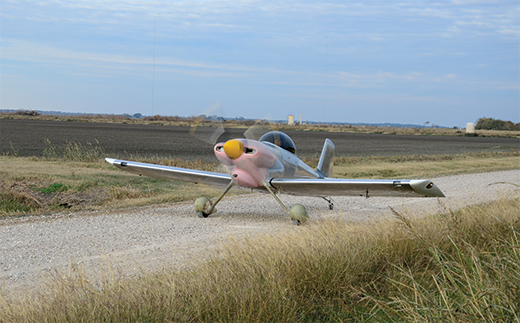
Chase Plane Operations
By now you should be ready to handle that new airplane on the first flight. You’ve practiced for a low-altitude engine issue, are ready for distractions and have prepared in case the airplane’s handling is a bit off. Is there anything else you should work on? Well, are you planning to use a chase plane? This opens up an entirely new can of worms. Are you comfortable with another airplane in close proximity? Have you done this recently? Chasing is not formation flying, but it can turn out that way if you need to bring the other aircraft in close for a visual inspection. But let’s take a non-formation example. Most folks launch the chase plane into an orbit of the field before the test airplane takes off. Do you know where the chase is going to be for your takeoff? Has the chase pilot practiced positioning his or her airplane so that it won’t suddenly cross over and lose sight of you right after takeoff? It’s not just the test pilot who needs a little practice, and it is best if the two pilots practice together. For a typical first flight, I will fly a couple of complete rehearsals. I’ll use an airplane similar in performance to what I am going to test, and the chase plane will be (hopefully) the one we are going to use on the real day. We’ll go out and fly the planned test mission, including initial orbits, airspeed checks, communications, traffic patterns, etc. It could take pages to describe the details of this practice, but suffice it to say that although it’s complex, chasing is useful for a number of reasons. If you are not willing to practice it in airplanes that are proven, why would you risk adding it to the complexity of a first flight? Practice, practice, practice.
Ready for the Big Game
These are just a few of my warm-up techniques for the big game: the first flight of a new homebuilt. Sure, you can kick the tires, light the fire and go burn holes in the sky. This has worked for many people, many times. But sometimes it doesn’t, and you don’t get a do-over if you’re dead. Low, slow, without power and airspeed is no time to realize that you are out of landing options because you can’t remember what you learned (and last practiced) years ago in Private Pilot training. Take flight testing seriously: plan and practice. This will require you to burn some fuel and build some flight time, and what is wrong with that? You like to fly, don’t you?
With planning and practice out of the way, it’s finally time to go fly that new beast you’ve rolled out into the sun for the first time. We’ll talk about that first flight next time, as we plan, train and fly.


